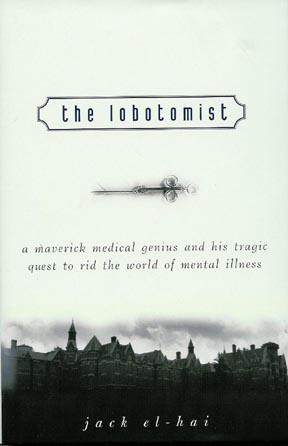Good Intentions: Jack El-Hai’s “The Lobotomist”
George Slade reviews Minnesota writer Jack El-Hai's "The Lobotomist": a level gaze at an almost unthinkably barbarous practice that was once accepted. (Please note the link at the foot of this article to the fascinating related musical performance.)

The Lobotomist: A Maverick Medical Genius and His Tragic Quest To Rid the World of Mental Illness
By Jack El-Hai
Hoboken, New Jersey: John Wiley and Sons, 2005
It’s a good thing that a well-mannered, slow-to-anger Minnesotan wrote this book. Jack El-Hai’s accumulation of data and anecdotes in the life of Walter Jackson Freeman, an articulate, brilliant man who chose to devote his intellect and energies to a beastly bit of business, is careful, even respectful in its withholding of judgment. The measured development of the story—nay, the plot—is even suspenseful; I found myself wondering when demonic Hyde would break forth from this meticulous, self-assured Jekyll.*
El-Hai also accommodates the squeamish; his even tone helps lessen the impact of the more gruesome procedures Freeman performed in his “ice pick” lobotomies.
By Chapter 11 (“Road Warrior”), however, the narrative can’t mask the terror implicit in Freeman’s ambition to become the “Henry Ford of Psychiatry”; in one day, working at one of many hospitals he visited in West Virginia during the summer of 1952, Freeman performed lobotomies on 25 patients. He later referred to what El-Hai describes as his “lobotomy campaign”that summer as “a gratifying experience,” the successful mass marketing of his desire to radically transform the field of psychosurgery. His major disappointment was that few local psychiatrists or surgeons decided to adopt his methods.
But in his later follow-ups with patients, a commendable, surprisingly humanitarian aspect of his practice, Freeman found in 1960 that of 787 individuals he’d operated on in West Virginia between 1952 and 1955, ninety percent were schizophrenic, but 44 percent were out of institutions, which seems to have been Freeman’s mission. As he put it, “personality changes brought about by lobotomy definitely increase the chances of discharge from the hospital,” even after lengthy confinement. Over ten years, however, Freeman’s records indicate that approximately two-thirds of his patients failed to show improvement, which strikes me as a weak endorsement of lobotomy.
Freeman (1895 – 1972) followed his grandfather and father into the medical profession. It is a mark of the conflicts within twentieth-century medicine that he was given as much credibility and indulgence as he was, and not imprisoned for what at times seems like unconscionable cruelty and disregard for patients’ well-being. In an era in which we have scores of psycho-pharmacological keys to unlocking the doors of depression, anxiety, and other mental illnesses, it is startling to think that during my parents’ lives doctors felt that radical surgery, the intentional maiming and removal of brain matter, could be a more effective means of treating mental illness.
And, despite its innate relationship to the pithing of lab animals, frontal (access through holes drilled in the skull), or transorbital (through the upper eye socket) lobotomy was a latter-stage surgical solution; earlier procedures included inducing comas with insulin shock, instigating pseudo-epileptic convulsions with Metrazol (a drug similar to camphor), and from everyone’s top ten medical nightmares list, electroshock. (Here is El-Hai’s rendering of “insulin therapy units”—“quiet, eerie places, with rows of comatose patients arranged in beds, and attended by staff trying to keep them from dying from hypoglycemia.”)
The tension between hands-on and hands-off treatment continues. The western tendency toward surgical intervention (pushed by technological advances, pharmaceutical and industrial profits, and managed health care’s Byzantine motives) apparently takes precedence in “developed” nations. Freeman’s ideological heirs are now utilizing a high-tech brain scan called Spect, or single photon emission computed tomography, in attempts to situate and identify mental illness in the brain. While their results may be more precise than Freeman’s, who seems to have accepted an enormous amount of guesswork, impressionistic and subjective assessment , into his research and practice, the spectre of physical tampering with the brain implied in the term psychosurgery is still largely the domain of medical fantasts and misanthropic social engineers. El-Hai’s accounting of Freeman’s particular, tragic course is an important reminder of the allure and shortcomings of expedient solutions and a cautionary tale about professional passion within a field concerned with the complexity of human wellness.
* Note: El-Hai quotes a New York Times reviewer of Freeman’s 1942 book Psychosurgery claiming that it was “more exciting than most novels. And why not? Probing into the brain…no novelist ever had a more thrilling subject.”
Related Media: Art Ventures into Madness
Arnold Schoenberg’s String Trio, opus 45, can be heard here as background music. Read Allen Shawn’s Arnold Schoenberg’s Journey for an explanation of the piece as Schoenberg’s “delirium trio,” a musical transcription of radical surgical procedures. You can attend the Bakken Trio’s performance of the piece on March 13 at the Southern Theater; click on the link below.
Frances, director Graeme Clifford’s1982 biopic starring Jessica Lange as the troubled actress Frances Farmer. In the film, Farmer is subjected to a frontal lobotomy (the neurosurgeon’s self-described “ice pick technique,”preceded by insulin shock treatment and electroshock) by a figure resembling Freeman, with the blithely callous explanation that “lobotomy gets ‘em home,” a phrase that echoes Freeman’s writings quoted in The Lobotomist. El-Hai cites extensive evidence that Farmer was never lobotomized or a patient of Freeman’s, but Frances still sticks.